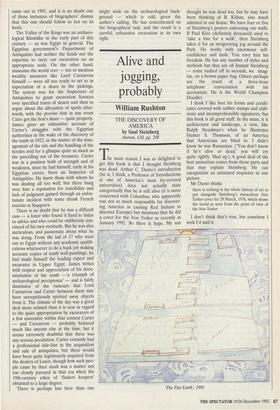Alive and jogging, probably
William Rushton
THE DISCOVERY OF AMERICA by Saul Steinberg Aurum, £30, pp. 208 he main reason I was so delighted to get this book is that I thought Steinberg was dead. Arthur C. Danto's introduction (he is, I think, a Professor of Introductions at one of America's most ivy-covered universities) does not actually state categorically that he is still alive (it is more concerned with Columbus, who apparently was not so much responsible for discover- ing America as causing Red Indians to discover Europe) but mentions that he did a cover for the New Yorker as recently as January 1992. So there is hope. My son thought he was dead too, but he may have been thinking of B. Kliban, also much admired in our house. We have four or five of Steinberg's posters enlivening our walls. If Paul Klee (definitely deceased) used to 'take a line for a walk', then Steinberg takes it for an invigorating jog around the Park. He works with enormous self- confidence and dash. You envy him his freedom. He has any number of styles and methods but they are all Instant Steinberg — some rushed off in seconds, we imag- ine, on a brown paper bag. Others perhaps are the result of a three-hour telephone conversation with his accountant. He is the World Champion Doodler.
I think I like best his forms and certifi- cates covered with rubber stamps and elab- orate and incomprehensible signatures, but this book is all good stuff. In the main, it is architecture and landscape, a view, like Ralph Steadman's when he illustrates Hunter S. Thomson, of an America that Americans are blind to. I didn't know he was Rumanian. (`You don't know if he's alive or dead,' you will cry quite rightly. Shut up.) A good deal of the best animation comes from those parts and that may explain Steinberg. He can encapsulate an animated sequence in one picture.
Mr Danto thinks
there is nothing in the whole history of art to put alongside Steinberg's miraculous New Yorker cover for 29 March, 1976, which shows the world as seen from the point of view of the New Yorker.
I don't think that's true, but somehow I wish I'd said it.
'The Flat Earth', 1991










































































































 Previous page
Previous page